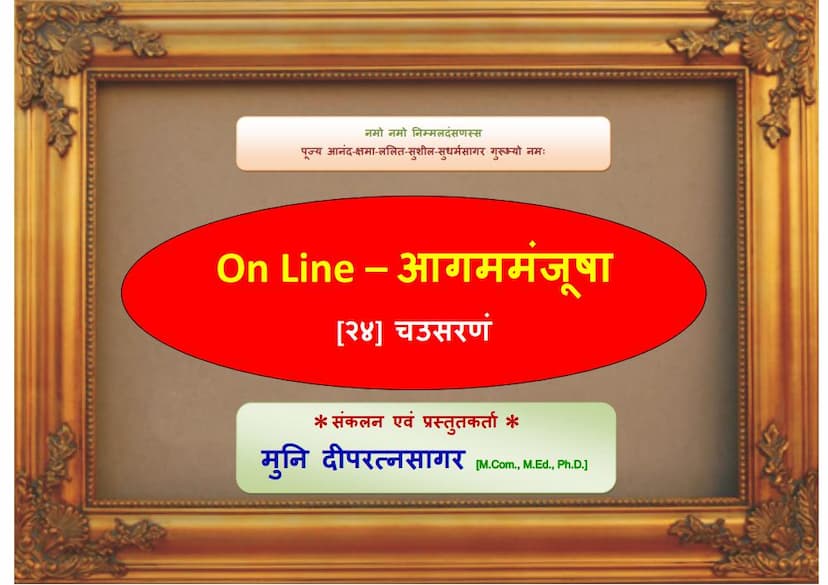Aagam Manjusha 24 Painnagsuttam Mool 01 Chausaranam
Added to library: September 1, 2025

Summary
Here's a comprehensive summary of the Jain text "Aagam Manjusha 24 Painnagsuttam Mool 01 Chausaranam" based on the provided pages:
The text is an online presentation of the "Chausaranam" (Four Refuges) from the Agam Manjusha, a collection of Jain scriptures.
Introduction and Context:
- The "Aagam Manjusha" was originally compiled about 70 years prior to the online release (around 1942 CE / Vir Samvat 2468) by Acharya Shri Anandasagar Suri.
- The current online version, presented in 2012 CE / Vir Samvat 2538, is an updated rendition of the original, incorporating useful changes and making it accessible online for the first time.
- Key changes and inclusions in this online edition compared to the original:
- Aavashyak Sutra (Agam-40): Includes not just the original sutras but also their Niyukti (commentary/explanation).
- Jitkalpa Sutra (Agam-38): Includes not only the original sutras but also their Bhashya (detailed exposition).
- Jitkalpa Sutra (Agam-38) - Alternate "Panchakalpa": The Bhashya of the alternative "Panchakalpa" is also included.
- Oghniyukti (Agam-41) - Alternate "Pindniyukti": The alternative scripture "Pindniyukti" is included, though its printing location might differ.
- Kalpa (Barsa) Sutra: This sutra is also included in the online version.
The "Chausaranam" (Four Refuges) - Content and Significance:
The core of the text focuses on the concept of taking refuge in the Four Noble Entities of Jainism: Arihanta, Siddha, Sadhu (Acharya, Upadhyaya, Sadhu), and Dharma.
Page 3:
- The text begins with verses that discuss the purification of conduct and the importance of abstaining from sinful activities. It highlights the practice of Samayika (equanimity) and the renunciation of harmful actions.
- It emphasizes the praise of the virtues of the Arihantas and the purification of the soul through various means.
- The Four Refuges are explicitly stated:
- Arihanta: The enlightened beings who have conquered their passions and the cycle of birth and death.
- Siddha: The liberated souls who have attained eternal bliss and omniscience.
- Sadhu: The righteous monks who follow the path of austerity and spiritual practice.
- Dharma: The true doctrine or path of liberation as taught by the Arihantas.
- The text then delves into detailed verses praising each of the four refuges:
- Verses praising Arihantas: They are described as conquerors of passion and desire, those who have left worldly possessions, achieved omniscience, are worshipped by celestial beings, are eternal and blissful, and whose contemplation leads to righteousness. They are those who have conquered birth, old age, and death, and bring happiness to the three worlds.
- Verses praising Siddhars: They are described as those who have attained the highest state of spiritual perfection, are free from ignorance, possess complete knowledge and perception, have achieved all goals, are supremely blissful, and are the true refuges. They are described as unattached, flawless, and the source of ultimate happiness.
- Verses praising Sadhus: They are the guides of the Jain path, those who have renounced the world, are free from attachment and aversion, possess virtues, have conquered desires, and are the path to spiritual bliss. They are praised for their righteous conduct, renunciation of worldly pleasures, and detached nature.
- Verses praising Dharma: It is described as the path of non-violence, truth, and austerity, the path of liberation, and the teachings of the Arihantas. It is also referred to as the path that leads to the cessation of karma and the attainment of ultimate bliss.
Page 4:
- This page continues the detailed praise of Dharma, describing it as the path leading to liberation from the cycle of birth and death, the path of virtue and righteousness, and the path that has been taught by the omniscient ones.
- It reiterates the importance of seeking refuge in Dharma, which is described as the path that eradicates sin and leads to ultimate happiness.
- The text emphasizes the importance of repenting for wrongdoings (Dukhad-garīhā) and rejoicing in good deeds (Sukhad-anumodanā). This is presented as a crucial aspect of spiritual practice.
- It specifically mentions repenting for actions contrary to the Jain teachings, such as those born of ignorance, attachment, or wrong beliefs.
- The text highlights the importance of understanding the path of Arihantas, Siddhars, Acharyas, Upadhyayas, and Sadhus. It also emphasizes the acceptance of the right faith (Samyaktva) and the practice of vows, whether complete or partial.
- The ultimate goal is to reduce internal impurities or afflictions (Sanklesha) and cultivate pure conduct (Sukruta) that leads to favorable karma and ultimately liberation.
- The concluding verses lament the missed opportunities for liberation due to negligence and incorrect practices, emphasizing that neglecting the four refuges leads to the continuation of the cycle of birth and death.
Overall Message:
"Chausaranam" is a foundational text that guides Jain followers on the path to spiritual liberation by emphasizing the critical importance of taking refuge in the Four Noble Entities: Arihantas, Siddhas, Sadhus, and Dharma. It underscores the necessity of virtuous conduct, repentance for sins, and unwavering devotion to the Jain path for achieving ultimate happiness and freedom from suffering. The online presentation aims to make these essential teachings accessible to a wider audience.